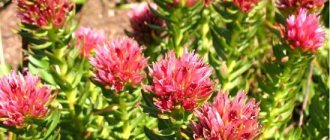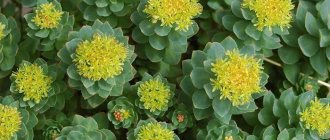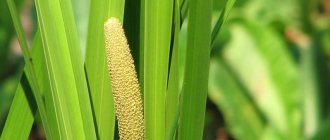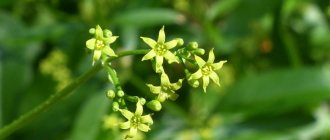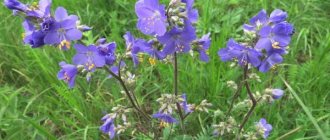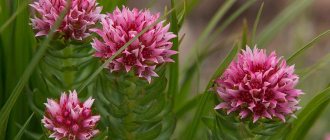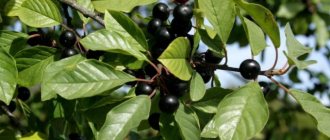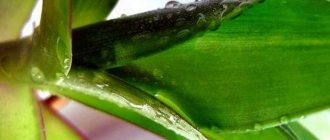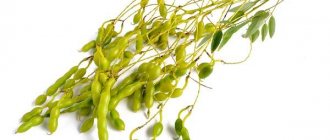Emetic root or ipecacuanha (Carapichea ipecacuanha) - the plant belongs to the Rubiaceae family. It is evergreen and has a height of twenty to forty centimeters. The leaves are elongated oval, entire, arranged oppositely, and have stipules. The flowers are small, located in inflorescences at the tops of the shoots and make the plant quite attractive. Ipecac has long, thin rhizomes from which roots emerge. The fruit is a fleshy drupe containing small seeds inside. The homeland of the vomiting root is the rainforests of Brazil; it grows along the banks of tributaries of the Amazon. This plant is cultivated in Indonesia, Tanzania and India. If the soil is rich in humus, then the plants are located in entire colonies.
Botanical features
Ipecac belongs to the genus Carapichea, besides it there are 5 more species of tropical plants, but ipecac is the most common of them. The evergreen shrub grows up to 40 cm.
On a thin stem, opposite each other, there are whole oblong leaves with stipules. A bouquet of small white flowers up to 6 mm long is formed in the upper part; in the first phase of flowering they are erect, then drooping.
The formula of the emetic root flower is * H(4-5)L(4-5)T4-5P(2).
The fruits are egg-shaped, fleshy, blue-black in color with white-yellow seeds. The root is gray-brown in color, thin, tap-shaped, located horizontally. In the nodules, long roots with a special structure grow from it: on top they are covered with bark, below - thin but durable wood.
Ipecac comes from the Brazilian tropics and is most found on the Amazon coast, in Matto Grosso. Of course, natural reserves of the root do not cover all the needs of the pharmaceutical industry, so in Ceylon, the islands of Java, Tanganyika, Indonesia, and India, it is also grown under artificial conditions. They tried to cultivate the subshrub in Crimea, but the experiments did not justify themselves.
The homeland of emetic root is the magnificent, humid and shady forests of Brazil
Origin of Ipecac
The homeland of the Carapichea ipecacuanha shrub is Brazil. Its dried roots are used to make emetics and expectorants. The emetic root was brought to the continent by the Portuguese: Brazilian aborigines told the monks the secret of a miraculous drug for bloody diarrhea. The therapeutic practice of the West adopted ipecac thanks to Helvetius, the court physician of the Prince of Orange, who healed his ruler of dysentery. Later, he sold his secret to Louis XIV, saying that the product, in addition to other herbal ingredients, contained powder from crushed ipecac root.
Ipecacuanha
Procurement of raw materials
Harvesting rhizomes of vomit root can be done at any time of the year - the main thing is that the weather is favorable at the time of collection. The bush is carefully dug up, freed from thin roots, leaving only clear-shaped ones.
The part of the root unsuitable for harvesting is immediately covered with soil so that after a few years the rhizome regains its strength. The excavated raw materials are cleaned of impurities and soil and dried in the sun.
The blanks are pieces of roots up to 5 mm thick with a fragile, easily removable bark. It is the bark of the bush that has therapeutic value.
Composition and pharmacological characteristics
In the rhizome of ipecac, alkaloids (up to 3.5%) were found in the form of emetine, cephaelin, psychotrine, ametamine, protoemethine, 2% triterpene saponins and 0.4% ipecacunin glycoside. The rhizome is also rich in saponins, phytosterol, choline, citric and malic acids.
The therapeutic capabilities of the root are due to the presence of emetine in its composition. By irritating the gastric mucosa, this alkaloid reflexively provokes a gag reflex. The substance is effective in combating pathogens of amoebic dysentery.
As an emetic, ipecac root is weaker than apomorphine hydrochloride, but its expectorant effect is superior to its analogue, since it has prolonged properties. For cough, root emetic is prescribed when the symptoms include viscous, poorly separated sputum.
Ipecac preparations are prescribed for inflammatory processes of the respiratory system: bronchi, lungs, upper respiratory tract. When treating with emetic root, it is important to follow the recipe and dosage.
The medicinal properties of ipecac are primarily due to the content of the alkaloid emetine.
Emetic root - medicinal properties and uses
Emetic root (ipecac) is an evergreen shrub of the Rubiaceae family. Its average height does not exceed 20 cm. There are rare specimens of the plant up to 40 cm in height.
the entire elongated leaves have an opposite shape with the stipules. Small white-cream flowers are located directly at the tops of erect stems. Such peculiar capitate inflorescences make the plant very attractive.
The beautiful tubular flowers do not grow more than 6 mm in length.
The emetic root has thin, smooth rhizomes with numerous annular-type roots emerging. The plant grows in the rainforests of Brazil or along the banks of the Amazon River.
Recently, it has been frequently cultivated in Indonesia and India. Vomit root often settles in entire colonies on soil rich in humus. The simple, unbranched stem is woody at the base.
The stipules on the stems are deeply dissected into special subulate-shaped lobes.
The fruit of the vomit root is an ovoid, fleshy drupe. The red-purple fruit has small seeds inside.
Collection of roots for medicinal purposes can be carried out at any time of the year, with the exception of rainy periods.
When digging, it is necessary to leave a small part of the root in the ground so that the plant can further develop and grow. The collected roots have a bitter taste, and the smell is very tart and pungent.
Emetic root - beneficial properties
The pharmacological effect of the plant is due to its unique composition. Many different alkaloids have been found in the roots. These include amphetamine, cephaelin, protoetin and psychotrin.
The emetic root also contains saponins, malic and citric acids, phytosterol and choline. When used correctly, various remedies have an excellent expectorant effect.
Due to the special ability to reflexively enhance the important secretory function of the lungs and bronchial glands, sputum is significantly diluted and easily removed.
Emetic root is used to treat:
- severe cough with viscous thick sputum and suffocation;
- bronchial catarrh, bronchial asthma, bronchopneumonia;
- laryngitis, tracheitis, whooping cough;
- shortness of breath, loss of voice as a result of a cold;
- intestinal hemorrhages, if they are not associated with mucosal ulcers;
- uterine bleeding, heavy menstruation, coughing up blood;
- inflammation of the stomach and intestines;
- catarrh of the stomach with vomiting mucus;
- nausea due to toxicosis in pregnant women;
- diarrhea with blood or mucous discharge, dyspepsia;
- dysentery;
- inflammation of the membrane, eye ulcers;
- severe headache, unilateral migraine.
With long-term use of the drug, the activity of the villi of the unique ciliated epithelium of all respiratory tracts significantly improves.
However, it should be mentioned that in large doses, any drug based on emetic root causes nausea and severe irritation of the gastric mucosa. This inevitably leads to uncontrollable vomiting.
In ancient times, healers knew about this characteristic of the plant, and often prescribed just such roots when it was necessary to cleanse the stomach.
Today, emetic root is used only as a miracle cure for coughs to ease the expectoration process. There are special preparations made from emetic root and marshmallow syrup.
To tame a cough and remove phlegm, various infusions and powders are prescribed. They are also effective against amoebic dysentery.
Emetic root - use in folk medicine
The main indications for use are acute and serious chronic diseases and inflammation of various types of the respiratory tract.
Many preparations based on emetic root are recommended for use in case of difficulty in the discharge of rather viscous sputum. The use of emetic root in homeopathy is widely used.
To get rid of phlegm in the bronchi, a special drug is prescribed in low dilutions. To quickly solve problems with the gastrointestinal tract, higher dilutions are indicated.
- An aqueous tincture is taken for respiratory diseases, laryngitis and whooping cough . To do this, 0.4 g of root powder (extract) is mixed with 180 ml of water and left in a cool, dark place for 2 days. Take no more than 3-4 times a day, a large spoon for adults, and a small spoon for children. If you need to use the infusion as an emetic, you should dissolve half a gram of powder and drink it once. The latter should not be used for children.
- Alcohol tincture is taken as an expectorant for adults . For it, the fresh root is poured in a ratio of 1 to 10 with 70% alcohol (for powder the ratio is 1:9) and left for a week in a dark place. After filtering, take 2-3 times a day, 5-10 drops, but not more than 20 drops in total.
- Ipecac syrup is used in small doses for severe coughs, bleeding and migraines . To prepare it, you need to mix the finished tincture with any sugar syrup. Drink 2-4 g no more than 3 times a day. To induce vomiting, increase the dose to no more than 5-6 g and drink once.
Various infusions, syrups and powders from emetic root are effective in many inflammatory processes. By increasing the amount of dry roots in the preparation, it turns into an emetic, on the basis of which a medicine is made against dangerous amoebic dysentery. The powder is easily soluble in water, it has an unpleasant odor and a bitter, astringent taste.
Emetic root syrup
A unique syrup of emetic root can be prepared at home. To do this, you will need a tincture of the plant and sugar syrup. These two ingredients should be mixed in a ratio of 1:10.
As a rule, adults are prescribed no more than two grams per dose of medication. Weak concentrations in small doses of alkaloids enhance the secretion of the bronchial glands.
Due to this, there is an increased dilution of sputum and stimulation of the ciliated channel, which is responsible for free breathing.
This drug has a special advantage over apomorphine, since it is absorbed more slowly, which means a long-term effect during treatment is guaranteed.
Contraindications for emetic root
When consuming root emetic, some people experience allergic reactions, nausea and, in extremely rare cases, vomiting.
The plant should not be used as an emetic in the following cases:
- disturbances of consciousness;
- childhood up to six months;
- if you urgently need to remove substances from the stomach before they begin to be absorbed;
- poisoning with acids and alkalis;
- swallowing a hard or sharp object;
- hemorrhagic diathesis;
- taking non-toxic substances;
- if vomiting delays the onset of action of the antidote.
In case of hypersensitivity to the components of the drugs presented, it is recommended to stop treatment. In large doses, the roots severely irritate the mucous membranes of the respiratory tract.
Source: https://medicine-popular.ru/rvotnyj-koren-lechebnye-svojstva-i-primenenie/
Contraindications and undesirable consequences
It is no coincidence that Ipecac is popularly called emetic root. The effect of medications based on it is close to dyspeptic disorders. In addition to nausea and vomiting, after taking the drug you can experience chills, increased sensitivity of the skin, redness of the eyes, and swelling of the mucous membrane.
If shortness of breath appears, you can expect attacks of suffocation (as with asthma). Sometimes the remedy causes stool upset.
There are few contraindications for the root, but they must be taken into account. In addition to individual intolerance to ipecac drugs, these include children (up to 6 months). For metabolic disorders and heart failure, emetine hydrochloride is not prescribed.
Inducing vomiting with ipecac after ingestion of sharp objects and poisoning with alkaline substances and acids is strictly prohibited.
Failure to follow precise instructions can cause muscle pain and dyspeptic disorders. In case of overdose, the drug serves as an inhibitor of the activity of the nervous and cardiovascular systems.
Contact of the powder with the skin can cause rashes; if through negligence it enters the respiratory tract, it can cause inflammation of the mucous membranes with symptoms of uncontrollable coughing. Why did ipecac deserve the attention of homeopaths if its use is associated with such discomfort?
Getting ipecac powder on your skin can cause rashes.
Emetic root - medicinal properties, uses and recipes
Emetic root is a gorgeous evergreen shrub of the Rubiaceae family. Its average height does not exceed 20 cm. There are rare specimens of the plant up to 40 cm in height.
the entire elongated leaves have an opposite shape with the stipules. Small white-cream flowers are located directly at the tops of erect stems. Such peculiar capitate inflorescences make the plant very attractive.
The beautiful tubular flowers do not grow more than 6 mm in length.
The emetic root has thin, smooth rhizomes with numerous annular-type roots emerging. The plant grows in the rainforests of Brazil or along the banks of the Amazon River.
Recently, it has been frequently cultivated in Indonesia and India. Vomit root often settles in entire colonies on soil rich in humus. The simple, unbranched stem is woody at the base.
The stipules on the stems are deeply dissected into special subulate-shaped lobes.
The fruit of the vomit root is an ovoid, fleshy drupe. The red-purple fruit has small seeds inside.
Collection of roots for medicinal purposes can be carried out at any time of the year, with the exception of rainy periods.
When digging, it is necessary to leave a small part of the root in the ground so that the plant can further develop and grow. The collected roots have a bitter taste, and the smell is very tart and pungent.
Beneficial properties of emetic root
The pharmacological effect of the plant is due to its unique composition. Many different alkaloids have been found in the roots. These include amphetamine, cephaelin, protoetin and psychotrin.
The emetic root also contains saponins, malic and citric acids, phytosterol and choline. When used correctly, various remedies have an excellent expectorant effect.
Due to the special ability to reflexively enhance the important secretory function of the lungs and bronchial glands, sputum is significantly diluted and easily removed.
With long-term use of the drug, the activity of the villi of the unique ciliated epithelium of all respiratory tracts significantly improves. However, it should be mentioned that in large doses, any drug based on emetic root causes nausea and severe irritation of the gastric mucosa. This inevitably leads to uncontrollable vomiting.
In ancient times, healers knew about this characteristic of the plant, and often prescribed just such roots when it was necessary to cleanse the stomach.
Today, emetic root is used only as a miracle cure for coughs to ease the expectoration process. There are special preparations made from emetic root and marshmallow syrup.
To tame a cough and remove phlegm, various infusions and powders are prescribed. They are also effective against amoebic dysentery.
Use of emetic root
The main indications for use are acute and serious chronic diseases and inflammation of various types of the respiratory tract.
Many preparations based on emetic root are recommended for use in case of difficulty in the discharge of rather viscous sputum. The use of emetic root in homeopathy is widely used.
To get rid of phlegm in the bronchi, a special drug is prescribed in low dilutions. To quickly solve problems with the gastrointestinal tract, higher dilutions are indicated.
Various infusions, syrups and powders from emetic root are effective in many inflammatory processes. By increasing the amount of dry roots in the preparation, it turns into an emetic, on the basis of which a medicine is made against dangerous amoebic dysentery. The powder is easily soluble in water, it has an unpleasant odor and a bitter, astringent taste.
Indications for the use of ipecuana syrup (emetic root)
Using Ipecac Syrup
indicated for conscious patients who will benefit from vomiting, if they have no contraindications to the use of this drug. Vomiting as a way to reduce absorption from the gastrointestinal tract is usually ineffective when more than 4-6 hours have passed after ingestion of the toxin, unless the toxin itself slows down this absorption.
To other factors
that may reduce the rate of absorption include the presence of food in the stomach, the use of certain medications (anticholinergics, narcotics, ganglion blockers, aluminum hydroxide), and changes in clinical status associated with intoxication (eg, pain, ulcer, intestinal obstruction, acute abdomen, trauma, myocardial infarction ).
A dose of ipecuana syrup (emetic root) to induce vomiting and cleanse the stomach
In children aged 6-12 months
the dose is 5-10 ml plus 15 ml of pure liquid per 1 kg of body weight.
For children aged 12 months to 12 years
it is equal to 15 ml plus 240 ml of pure liquid.
In children aged 1 to 5 years, 30 ml of ipecac syrup reduced the average time to onset of vomiting by 10 minutes (from 25 to 15 minutes) compared with the effect of 15 ml of this syrup.
Although in the group of children who received 30 ml (no one was given 15 ml), six attacks of vomiting were observed, 60 minutes after administration, no urge to vomit was observed in any patient.
From age 12
the dose is 30 ml plus 240-480 ml of pure liquid. If vomiting is not observed, the same amount can be given after 20-30 minutes.
The decision to lavage the stomach if vomiting is not induced should be made taking into account the need to remove the toxin, since therapeutic doses of ipecac are not cardiotoxic.
Adding excess fluid may enhance absorption by dissolving the tablets and pushing toxic stomach contents into the duodenum.
Dilution is only indicated in case of ingestion of caustic substances.
Movement of the patient does not reduce the time before the onset of vomiting, but drinking milk increases it (the frequency of attacks remains the same; perhaps due to retention of contents in the stomach).
Although the official shelf life of ipecac syrup is 5 years, there is no documented significant reduction in its effectiveness after this period.
Contraindications for Ipecuana Syrup (Root Emetic)
a) Relative contraindications
.
Substances that induce epileptic seizures and rapid onset of coma, long-acting theophylline preparations, pregnancy, bleeding diathesis, uncontrollable vomiting, serious heart disease, poorly absorbed hydrocarbons, and the intended use of complete intestinal lavage are relative contraindications to the use of ipecac.
Other relative contraindications include situations in which too much time has passed since the toxin was ingested or the patient has since vomited; ingested substance tends to cause bradycardia (digitalis, beta blockers, calcium channel blockers), and cases where the patient is too young or too old. Ipecac-induced vomiting may result in bradycardia or may be exacerbated by vagal stimulation.
b) Absolute contraindications
. Emetic root is absolutely contraindicated in children under 6 months of age (although such a conclusion is not supported by sufficient clinical data), patients in a coma or with epileptic seizures, after ingestion of caustic substances and sharp solid objects, in the absence or impairment of the gag reflex.
Absolute contraindications also include ingestion of non-toxic agents.
(eg, individual berries or leaves, non-iron vitamin pills, acetaminophen below 100 mg/kg, some antibiotics, and Ex-Lax) and substances that cause mental status changes (antihistamines, opioids, benzodiazepines, ethanol, cyclic antidepressants, phenothiazines) and/or epileptic seizures.
Reliable evidence to prove or disprove the benefits of root emetic
for people more than 60 minutes after ingestion of the toxin, there are no. There are also quite a few controlled studies showing the effectiveness of using this drug even a few minutes after ingestion of a harmful substance.
Errors in using Ipecuana syrup (emetic root)
Wrenn et al.
found that the most common cases of inappropriate prescription of ipecac in children are associated with the ingestion of non-toxic substances, and in adults - drugs that cause changes in mental state. However, in principle, the most typical cases of incorrect use of this drug occur when it is administered too late (more than 60 minutes after taking the toxin).
Properties and use of elecampane, contraindications
Elecampane is a herbaceous perennial plant belonging to the Asteraceae family. According to ancient Russian beliefs, the herb was named that way because its rhizome had 9 healing properties.
The plant’s homeland is Central Asia, but it can also be found in Russia: in a forest, in a meadow, on the banks of a river or lake.
Recently, some gardeners have been planting elecampane in their dachas as a medicinal plant.
Elecampane root
Elecampane has a multi-headed rhizome on a thick root. This is the most valuable part of the plant. The height of the grass sometimes grows up to 2.5 m. It has an erect stem that is branched towards the top. The foliage is large, elliptical in shape with teeth along the edge, can reach 50 cm in length and approximately 30 cm in width.
The inflorescence is a little similar to a sunflower, although not so large in diameter, which is why the plant is popularly called wild sunflower. The grass blooms from July to autumn, and bears fruit around August-October. This medicinal plant has a bitter taste and pleasant aroma.
Source: https://znakomydoctor.ru/lekarstvennye-rasteniya/rvotnyj-koren-lechebnye-svojstva-p
Indications for use
Ipecac is used for respiratory tract pathologies (semi-asthma and asthma, semi-bronchitis and bronchitis, whooping cough). For spasms in the throat, accumulation of mucus, or complete loss of voice, tincture or granules are also prescribed.
Medicines containing the active ingredient ipecac are well tolerated by children and pregnant women. For toxicosis and inflammation of the gastrointestinal tract, emetic root is prescribed. It is prescribed to children for dyspeptic disorders, defecation rhythm disturbances, and dysentery.
The emetic root is also indicated for pathologies of the nervous system: migraines and other types of headaches, fever and bleeding, inflammation of the choroid and cornea.
Ipecac in alternative medicine
Traditional healers, homeopaths, and herbal therapists use the rhizome in the same cases: as an expectorant and emetic. In minimal concentration, root extract thins sputum, helps with bronchial catarrh, whooping cough, shortness of breath, laryngitis, laryngospasms.
In high concentrations, ipecac is prescribed for typhoid and paratyphoid fever, hay fever, inflammation of the gastrointestinal tract, uterine and other bleeding, defecation rhythm disturbances, dyspepsia, as well as migraines, photophobia and various eye diseases.
Features of treatment with ipecac-based medications are related to the dosage form and diagnosis.
Granules
You need to take 8 pieces at a time. Frequency of administration – 3-4 times a day. The course of treatment is about one month (check with a specialist). The most favorable time is 30 minutes before meals or 60 minutes after. The granules are not swallowed or washed down - they are placed under the tongue and dissolved.\
